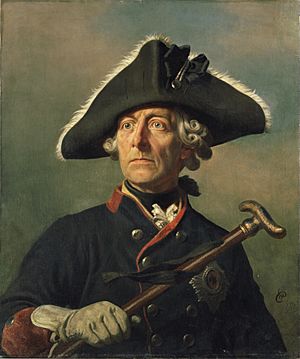Anglo-Prussian Alliance (1756) facts for kids

The Anglo-Prussian Alliance was a special agreement between Great Britain and Prussia. It was created by the Westminster Convention and lasted from 1756 to 1762. This alliance happened during a big war called the Seven Years' War.
The alliance allowed Britain to focus on fighting France in places like America and India. Meanwhile, Prussia did most of the fighting in Europe. Even after the alliance officially ended, Britain and Prussia remained good friends.
Contents
Why Did the Alliance Happen?
A Big Change in Alliances
Before this alliance, Britain had been friends with Austria since 1731. Prussia, on the other hand, was allied with France, Britain's enemy.
After a previous war, Austria lost an important area called Silesia. Empress Maria Theresa of Austria wanted Britain to help her get it back. But when the British government said no, she became upset.
In 1756, Austria decided to team up with France instead. This was a big change in how European countries were allied. It's often called the Diplomatic Revolution.
Britain Seeks a New Friend
Suddenly, Britain had no strong friends in Europe. So, they quickly made a deal with Frederick the Great of Prussia. They hoped this new friendship would stop a big war from starting in Europe. They also wanted to keep things balanced between the powerful countries.
Many important British leaders, like William Pitt the Elder, supported this new alliance with Prussia.
The Treaty of Westminster
| Type | Bilateral treaty |
|---|---|
| Signed | 19 January 1756 |
| Location | Westminster, England, Great Britain |
| Original signatories |
|
| Ratifiers |
|
The Treaty of Westminster was a neutrality agreement signed on January 16, 1756. It was signed between Frederick the Great of Prussia and King George II of Great Britain. King George II was also the Elector of Hanover.
Britain was worried that France might attack Hanover, a German territory linked to the British king. So, the treaty stated that Prussia and Great Britain would stop any foreign armies from moving through the Holy Roman Empire. This treaty was a key part of the Diplomatic Revolution.
How the Alliance Worked
War Begins in Europe
Even though Britain hoped to avoid war, Frederick of Prussia attacked Austria in August 1756. He quickly took over Saxony. But soon, many enemies attacked Prussia. These included France, Austria, Sweden, and Russia. Frederick had to retreat from Bohemia. By 1757, it looked like Prussia might lose without more help from Britain.
Frederick had a strong and well-trained army, but he often ran out of money. So, Britain started sending large amounts of money to help their ally. These payments were called subsidies.
Formalizing the Agreement
On April 11, 1758, Britain and Prussia signed another agreement. It was called the Anglo-Prussian Convention. This agreement made their alliance official. It stated that neither country would make peace without talking to the other first.
Britain also sent soldiers to Europe to help Prussia. These soldiers served with the Duke of Brunswick, who was a Prussian ally. This helped protect Prussia's western side, allowing Frederick to focus on other battles.
Turning the Tide
Britain also convinced the government of Hanover to rejoin the war on Prussia's side. Even with British help, Prussia's war effort almost failed in 1759. However, the allies did win an important battle at Battle of Minden.
Towards the end of the war, things started to go well for Britain and Prussia. Britain had a great year in 1759, winning many battles against France. They won in Europe, North America, and Asia. They also stopped France from invading Britain.
In 1762, Britain won more key victories against Spain. Also, the Russian Empress died, which led Russia to leave the war against Prussia. This was a huge relief for Prussia.
End of the Alliance
The alliance officially ended in 1762. Britain stopped sending money and military help to Prussia for its goals in Europe.
Britain then got better terms in the Treaty of Paris the next year. They gained many of the lands they had captured from France and Spain. Prussia kept Silesia but did not get the new territories it had hoped for at the start of the war.
Both countries made their own separate peace deals to end the war. After the war, their friendship became weaker. Prussia even turned down Britain's requests for a similar alliance later on. Instead, Prussia made an alliance with Russia in 1764. Britain was left without strong allies for a while.
However, after the American War of Independence, Britain and Prussia became friends again. They worked together during the Dutch Patriot Revolt in 1787. They also formed a Triple Alliance with the Dutch Republic in 1788. When the French Revolution began, both Britain and Prussia joined forces against France.
See also
- Great Britain in the Seven Years' War
- Anglo-French Alliance
- Anglo-Austrian Alliance
- Franco-Austrian Alliance
- Anglo-Prussian Alliance (1788)
- Germany–United Kingdom relations

